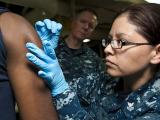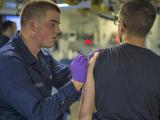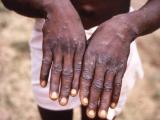Oct 1, 2003 (CIDRAP News) The consensus of a group of veteran health workers who helped eradicate smallpox in developing countries is that vaccination within 3 days after exposure to smallpox would protect most people from the disease, according to a report in Emerging Infectious Diseases.
The eradicators' confidence in postexposure vaccination supports the current position of the federal Advisory Committee on Immunization Practices (ACIP), which has recommended against preemptive (pre-event) smallpox vaccination for the public, the new report states.
Postexposure vaccination was used in the global eradication campaign, but few data are available on its effectiveness, notes the report by Mehran S. Massoudi and colleagues from the Centers for Disease Control and Prevention (CDC). Consequently, the authors decided to gather and analyze the opinions of eradication program veterans who had experience with postexposure vaccination. They used the "Delphi" method, described as a technique for systematically gathering expert opinion and building consensus while minimizing the influence of personalities and group dynamics. The authors found nine qualified people who agreed to serve on their panel, with field experience ranging from about 3 months to more than 8 years.
For people with no previous smallpox vaccination, the median view among the panelists was that 80% of those vaccinated within 3 days after exposure to smallpox would be protected from the disease. For those vaccinated within 6 hours and from 6 to 24 hours after exposure, the median view was that 93% and 90%, respectively, would escape the disease. However, vaccination from 4 to 7 days after exposure would provide only a 25% likelihood of protection, the panelists estimated.
The eradicators further estimated that postexposure vaccination would yield greater benefits for people with a history of smallpox vaccination in the distant past (more than 30 years before exposure to the disease) than for those with no prior vaccination. The median view was that vaccination within 3 days after exposure would protect 90% of people in that category and that vaccination within 24 hours would protect 95%.
The panel also predicted that if people did contract smallpox despite having a postexposure shot, the disease would be milder. The median opinion was that those vaccinated within 3 days after exposure would have a 75% probability of having "modified" disease. For those with remote previous vaccinations, the chance of having milder disease was put at 80%.
By combining the estimates of disease prevention and modification, the authors estimated how many people would contract disease of normal severity if they were immunized within 3 days postexposure. They concluded that the number would be 5% for totally susceptible people and 2% for those previously vaccinated.
The analysis suggests "that vaccination within 3 days of exposure to smallpox is effective in preventing disease and that, when disease prevention and modification are combined, few who are vaccinated within that period will develop disease of normal severity," the report states. "These findings support the assumptions that underlie current ACIP recommendations for only limited pre-event vaccination and for the use of a surveillance and containment strategy should a smallpox reintroduction occur."
The authors acknowledge that some may question their findings because they are based on "expert observation," not prospectively collected data. But a high level of protection with postexposure vaccination is biologically plausible and consistent with vaccination experience in other diseases, such as chickenpox, they say. In particular, vaccinia vaccination results in a shorter incubation period than what occurs in typical exposure to smallpox itself, because the vaccinia infection bypasses the respiratory tract.
However, the authors also note some limitations of their study. One is that the survey involved a limited sample of smallpox eradication veterans. Also, the panelists had worked in developing countries where smallpox was endemic and vaccination coverage levels were high. Because of this, low levels of smallpox transmission that were attributed to postexposure immunization could have actually resulted from partial immunity among the population.
Massoudi MS, Barker L, Schwartz B. Effectiveness of postexposure vaccination for the prevention of smallpox: results of a Delphi analysis. J Infect Dis 2003;188(1 Oct):973-6 [Abstract]
See also:
ACIP statement on smallpox preparedness and vaccination
http://www.bt.cdc.gov/agent/smallpox/vaccination/acipjun2003.asp

















